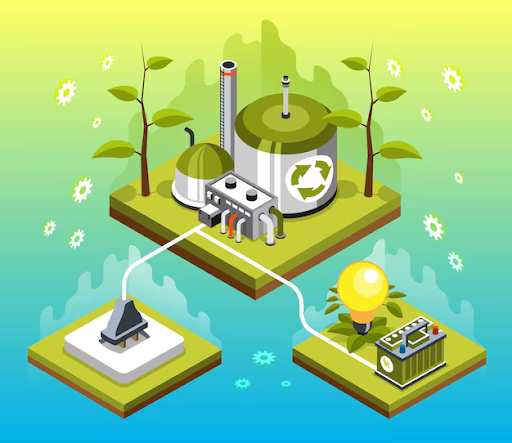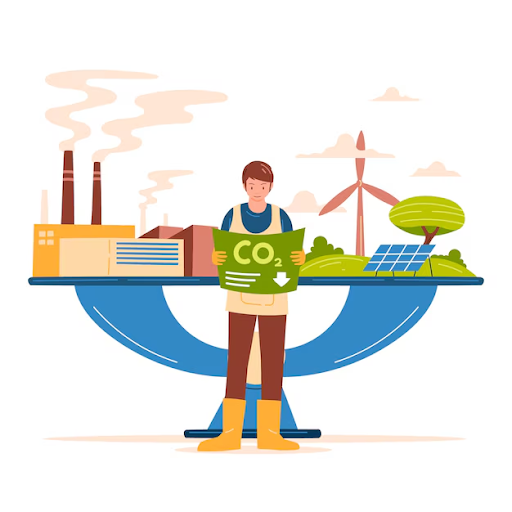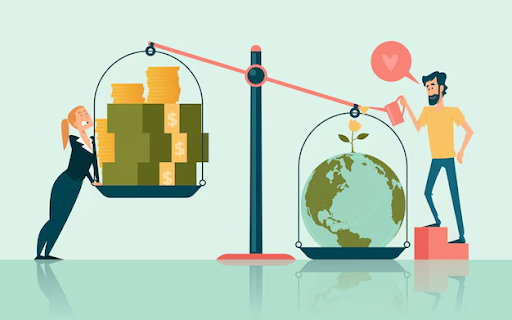The article below will provide a comprehensive overview of green transition in production, from concepts and benefits to practical solutions.
1. What is green transformation in production?

Green transformation in production is the process of comprehensively changing production activities to minimize negative environmental impacts while simultaneously enhancing resource efficiency. In simple terms, it is the process by which businesses transition from traditional, polluting production methods to more environmentally friendly production methods. This includes optimizing production processes, using renewable energy, minimizing waste, and recycling materials.
The core principles of the green transition include
- Sustainable resource use: Limit the exploitation of natural resources, encourage reuse.
- Reduce greenhouse gas emissions: Apply clean technology and improve production processes.
- Protecting ecosystems: Minimizing the impact on the natural environment
2. Why is green transformation in production necessary?

2.1. Climate change and environmental pollution
Currently, climate change and pollution are seriously affecting human life. The manufacturing sector, especially heavy industries, contributes a significant portion to global CO2 emissions. The transition to green manufacturing helps mitigate these negative impacts.
2.2. Market and customer demand
Consumers today are increasingly concerned about environmentally friendly products. Businesses adopting green production models not only meet market demands but also build a sustainable brand image, creating a competitive advantage.
2.3. Legal regulations
Many countries have enacted policies and regulations requiring businesses to implement environmental protection measures. Compliance with these regulations not only helps avoid legal risks but also opens up opportunities to access international markets.
3. The benefits of green transformation in production

3.1. Enhancing competitiveness
Green transformation is a powerful tool to enhance a company's competitiveness. By creating environmentally friendly products and services, businesses not only meet the growing demand of environmentally conscious consumers but also build a positive brand image. This helps businesses differentiate their products, enhance customer loyalty, and open up new business opportunities.
3.2. Reduce production costs
Green transformation is a win-win solution, benefiting both the environment and providing high economic efficiency. By optimizing energy use, minimizing waste, and building a sustainable supply chain, businesses not only reduce production costs immediately but also create a solid foundation for sustainable development in the future.
3.3. Enhancing production efficiency
To enhance production efficiency, businesses need to harmoniously combine modern technology with human factors. Automating repetitive production processes not only helps reduce errors but also frees up labor to focus on more creative and higher value-added tasks. In addition, training and enhancing the capabilities of the workforce are extremely important so that they can work effectively with new technologies and contribute to creating a safe and efficient working environment.
3.4. Minimize risks
Green transformation not only helps businesses minimize the risk of violating environmental regulations but also enhances the sustainability of production activities. By minimizing negative impacts on the environment, businesses not only contribute to protecting the planet but also build a positive brand image, attracting like-minded customers and partners. Moreover, mitigating climate change risks also helps businesses stabilize their production activities in the long term, reducing potential disruptions caused by extreme weather events.
3.5. Reducing environmental pollution, conserving natural resources
Green transformation in production is not merely about reducing pollution and conserving resources, but also a significant step towards a sustainable future. By reducing greenhouse gas emissions, waste, and energy consumption, we are contributing to the preservation of the living environment for future generations. At the same time, the efficient use of natural resources also helps ensure ecological balance and maintain sustainable economic development.
4. The key factors in the green transition

Green transition is a complex process that requires a comprehensive change in the way we produce and consume. To successfully implement this process, it is necessary to focus on the following key factors:
4.1. Green technology
Renewable energy: Investing in clean energy sources such as solar, wind, and water to replace fossil fuels.
Energy-saving technology: Implement advanced technologies to reduce energy consumption in the production process.
Waste treatment technology: Invest in modern technologies to efficiently treat waste and reduce environmental pollution.
Automation and digitization: Use digital tools to monitor, manage, and optimize the production process, minimizing waste.
4.2. Sustainable Supply Chain Management
Choose responsible suppliers: Collaborate with suppliers committed to sustainable production, minimizing environmental impact.
Minimize carbon emissions in transportation: Seek sustainable transportation solutions, optimize transportation routes.
Enhancing transparency: Building a transparent management system to monitor and assess the environmental impact of the supply chain.
4.3. Clean production
Minimize waste: Recycle and reuse materials as much as possible and reduce the amount of waste released into the environment.
Use recycled materials: Replace new materials with recycled ones to reduce the exploitation of natural resources.
Water conservation: Implement water-saving measures during the production process.
4.4. Innovation
Developing green products: Creating environmentally friendly products with a long product lifecycle and easy recyclability.
Sustainable product design: Apply sustainable design principles in the product design process.
Encouraging innovation: Create a work environment that encourages employees to be creative and come up with new ideas to improve the production process.
4.5. Sustainable corporate culture
Raise awareness: Organize activities to raise awareness about environmental protection for all employees.
Training: Train employees on knowledge and skills related to sustainable production.
Participate in community activities: Engage in community activities to contribute to environmental protection.
4.6. Policies and Regulations
State support policies on finance and taxes create favorable conditions for businesses to transition to green practices.
Comply with environmental regulations and international standards.
5. Solutions to promote green transition in production

Green transformation in production is a process that requires efforts from multiple parties, including businesses, the government, and society. Here are some important solutions to promote this process:
For businesses:
Invest in green technology: Implement advanced technologies such as renewable energy, automation, and artificial intelligence to increase production efficiency and minimize environmental impact.
Sustainable supply chain management: Build collaborative relationships with responsible suppliers, ensuring that input materials are produced sustainably.
Clean production: Implement production processes that are less polluting, use fewer harmful chemicals, and minimize waste.
Innovation: Developing new environmentally friendly products and services that meet market demands.
Sustainable corporate culture: Building a corporate culture that values environmental protection and sustainable development.
For the government:
Develop support policies: Enact tax and credit incentives, creating favorable conditions for businesses to invest in green technology.
Investing in infrastructure: Investing in renewable energy infrastructure, public transportation, and waste management.
Strengthen control: Strictly implement environmental protection regulations, enhance inspections, and address violations.
Raise awareness: Organize communication programs to enhance the community's understanding of the importance of green transition.
For society:
Promote green consumption: Customers should prioritize choosing environmentally friendly products and services.
Participate in community activities: Join volunteer activities and non-governmental organizations to contribute to environmental protection.
6. Sota Solutions – Accompanying manufacturing enterprises on the journey of Green transformation
Sota Solutions is a trusted partner, accompanying manufacturing enterprises on their green transformation journey. With a modern ERP software platform, we provide comprehensive solutions that help businesses effectively manage their supply chains, minimize waste, optimize energy use, and reduce environmental impact. From there, businesses not only enhance production efficiency but also contribute to the sustainable development of the community.
The team of experts at Sota Solutions is committed to accompanying businesses throughout the implementation and system support process, from solution consulting, deployment to training and maintenance. Thanks to their professionalism and dedication, Sota Solutions' ERP software helps manufacturing businesses optimize their operational processes, manage costs effectively, and enhance service quality, creating a solid foundation for sustainable development in the manufacturing industry.
7. Conclusion
Green transformation in production is not just a trend but also a revolution. By adopting green technologies, optimizing production processes, and building sustainable supply chains, businesses not only minimize negative environmental impacts but also create added value. However, the road ahead still holds many challenges. The government needs to implement strong support policies, businesses need to invest heavily in technology and innovation, and consumers need to be more conscious in their product choices.